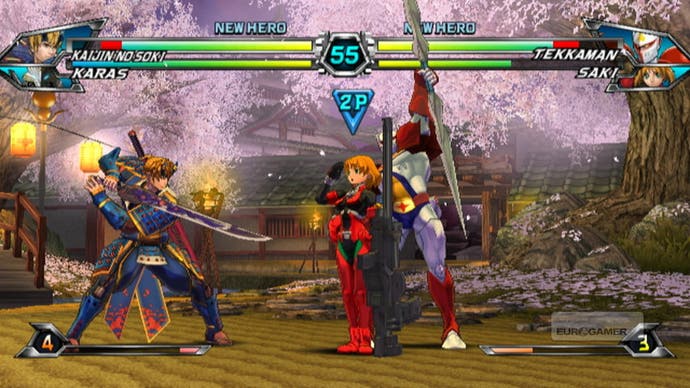Tatsunoko vs. Capcom: Ultimate All-Stars
A shining example.
For those who've not played Cross Generation the Tatsunoko fighting system can be seen as similar to Marvel, but with some significant changes - chief of which is the four button layout. By doing away with separate buttons for punches and kicks, Capcom has instead streamlined everything down to light, medium and heavy which, regardless of your Street Fighter experience, is fairly intuitive.
Another major difference is that we're back to the classic 2v2 tag-teams, with team tactics accessed via the fourth Partner button. But in a nutshell Tatsunoko is a slightly slower and more user-friendly Marvel, without losing the ability to pull-off crazy 50+ hit combos.
Tech-wise Tatsunoko also shares many of Marvel's more advanced mechanics, with hardcore players using Air Combos, Delayed Hyper Combos and Variable Combinations in-order to send the "billions" damage rating skyward. New systems are also introduced via the Variable Air Raid, Mega Crash and Baroque Cancel, with the Variable Air Raid giving the option to tag-out during an Air Combo, and the Mega Crash allowing you to interrupt the opponent's combo at the cost of one super stock.
Baroque Cancelling meanwhile isn't entirely dissimilar to Street Fighter IV's FAD Cancelling, but in effect works more like the classic Roman Cancelling from Guilty Gear. Overall these new systems add a bit of extra depth but don't change the pace dramatically.
It's a similar situation for the available modes. Capcom has furnished Ultimate All-Stars with all the usual suspects including arcade, versus, survival, time attack, training, shop and gallery. Nothing groundbreaking, but at least they've bested The King of Fighters XII.

The arcade mode also finishes with a fight against Yami, the end boss from Okami. This angry sphere of calligraphy has to be tackled over three stages in a similar style to Marvel's Abyss, but good timing and a solid defence will see most players through quickly.
After completing the arcade mode you're rewarded with a short piece of storyboard narrative. These are character specific and best described as fevered fan fiction. Expect to see Doronjo facing off against Devilotte from Cyberbots, as well as Tekkaman Blade and Hayato teaming up to take down Ghost Bilstein from Plasma Sword. Things get crazier still when Ken and Joe have an argument after Joe uses a Bird Missile to blow up the castle from Haunting Ground. Suffice to say the odd fanboy smiled will be raised.
But what didn't amuse is the online experience, as my hands-on with Ultimate All-Stars has so far been wobbly. All the functions are in place, with ranked and player matches as well as the ability to fight friends and players added as rivals, but the netcode hasn't shown itself to be particularly sturdy.

Indeed, so far it's been a bit of a lagfest, although this may be down to the lack of local players at the time of writing. Either way this is cause for concern as initial impressions suggest Ultimate All-Stars isn't as stable as Street Fighter IV. Once the game is released the situation may improve.
In summary Ultimate All-Stars is a highly polished fighter that strikes a good balance between casual accessibility and mechanical depth. Although the Tatsunoko element doesn't have the same western appeal as Marvel, it doesn't tarnish a familiar fighting system that offers new tech and fresh characters.
To say it's a good stopgap for Super Street Fighter IV would be an injustice, as it's a fighter that stands out on its own merit. Those who look beyond the tinted visors will discover not just an excellent Wii game but an all kinds of awesome 2D fighter.

